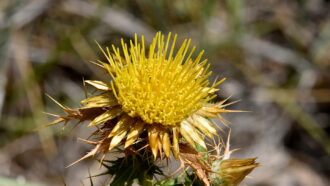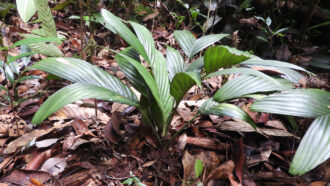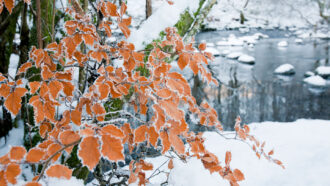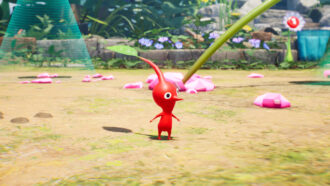Saving the banana
Scientists race against time to fight diseases threatening the survival of the world’s most popular fruit
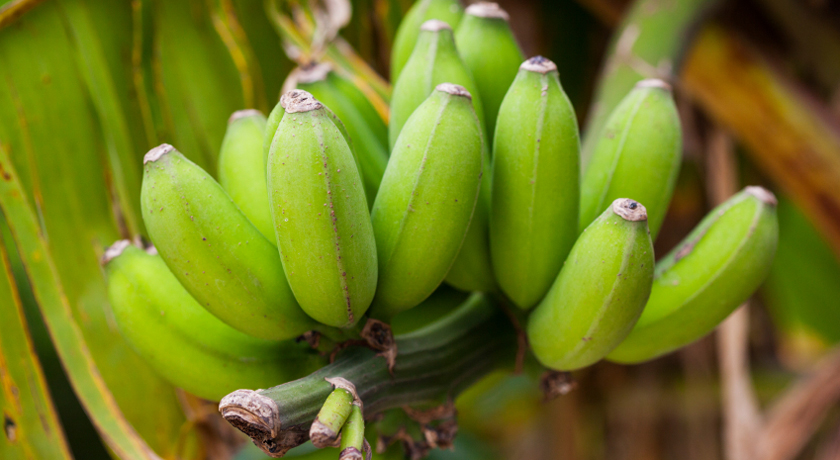
These berries — known across the world as bananas — are the world’s most popular fruit. They’re also being threatened by a host of diseases that could one day make them all but disappear from store shelves.
antb/ iStockphoto
Meet the world’s most popular fruit. Snack-size, portable and each with its own wrapper — it’s the banana! Diners consume billions each year throughout the world. Americans eat more bananas than apples and oranges combined. And in banana-producing countries, more than 400 million people rely on bananas in order to survive.
The big, bright-yellow banana most commonly found in American and European grocery stores is known as the Cavendish. Known as a dessert banana, it is eaten only when it is ripe and sweet. But dessert bananas make up only 40 percent of the world’s 400 edible varieties of this fruit. Bananas vary greatly in their size, shape, flavor and texture. Those that aren’t sweet, such as the plantain, must be cooked or fried before they are eaten.
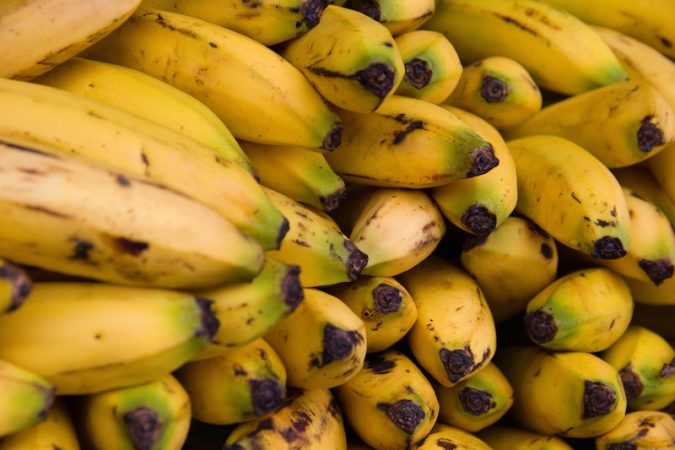
Despite their broad popularity, many bananas — including that popular Cavendish — could disappear from store shelves in the not too distant future. A variety of diseases threaten their survival. Among the biggest worries is a nasty soil-borne fungus known as Tropical Race 4, or TR4. It causes “Panama disease,” which makes plants wilt and die. Another fungus also causes Panama disease. Called Race 1, back in the 1950s it nearly wiped out one popular banana variety — the Gros Michel, or Big Mike. That’s when farmers switched to growing the Cavendish we eat today.
But now TR4 threatens not only the Cavendish, but also many other varieties of bananas. This aggressive fungus has moved from Asia to the Middle East, Australia and, most recently, Africa.
Losing out on a banana split wouldn’t be great. If these diseases succeed at wiping out popular types of this fruit, however, many people who live in banana-growing regions might starve. That’s why scientists are working with farmers to stop banana threats such as TR4 in their tracks. They are developing plants that resist the fungus. But it’s a race against time as this newest menace hops, skips and jumps around the globe.
Berry-liscious
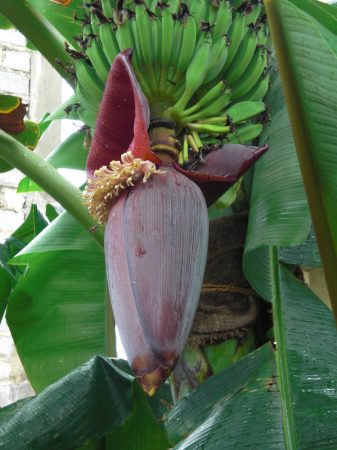
Bananas don’t grow on trees. Rather, they are the world’s biggest berries growing on the world’s tallest herb. Reaching a height of nearly 3.5 meters (11.5 feet), banana plants lack woody trunks. Instead, layers of leaf stalks support the towering structure. Broad leaves unfurl from the top. That’s also where an unusual cluster of flowers begins growing into “fingers” of fruit.
Banana plants grow fast. It takes most only about nine months to reach full height and begin flowering. Once the plant finishes producing fruit, the above-ground portion dies. A sucker (a kind of shoot) then begins to grow from the bottom of the plant. That sucker eventually develops into a new plant that produces more fruit.
Suckers play an important role in banana farming. The most common types of banana don’t produce any seeds. One way that farmers grow new plants from these types is by removing suckers from mature plants and transplanting them.
Large plantations, however, typically start new plants from tissue culture. That means they take cells from a plant, put them in a nutrient broth and allow those cell clumps to develop into new plants. Both processes result in clones: bananas that are essentially identical twins of their parent. These clones are being planted over and over throughout the world.
And that risks trouble. Because each plant now has the exact same set of genes, if one plant is susceptible to a disease, all its clones will be too.
Not all bananas are seedless, though. Some bananas contain dozens of pea-sized seeds. And those seeds may hold a key to protecting bananas from the diseases that threaten them.
Lurking threat
Last year, banana growers in Mozambique noticed some unhealthy plants. Their leaves had wilted and yellowed. They broke away from the stem, forming a skirt of dead leaves on the ground. Fearing the worst, farmers had their plants tested. The diagnosis: TR4 had arrived.
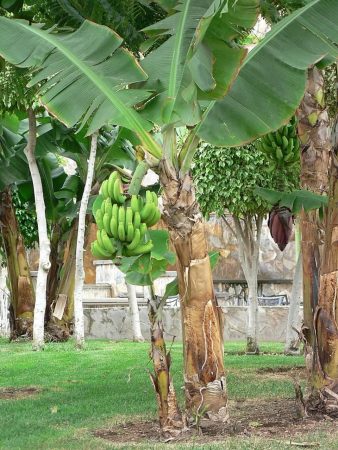
This fungus — and the Panama disease it causes — is one of the world’s biggest threats to bananas. The fungus first attacks the roots. Long fungal filaments, called hyphae, grow upward into a plant. They fill the tubes the plant uses to move food and water up into its leaves. The hyphae can cut off the nutrient supply, causing leaves to wilt. The name of the disease reflects the country where it was first discovered attacking Gros Michel bananas.
The 2013 Mozambique blight was the first time Panama disease had showed up in Africa, notes Altus Viljoen. An expert on this fungal disease, he works at Stellenbosch University in South Africa. He identified TR4 as the villain and instructed farmers in Mozambique on how to stop its spread.
No one knows how this pathogen, or disease-causing agent, reached Africa. But now that it’s there, TR4 has the potential to spread rapidly. That’s because this fungus can travel by irrigation water. It also can cling to soil on the bottom of shoes. And it can contaminate equipment, such as machetes.
Even careful control measures can’t completely protect plants from the fungus. That’s because TR4 is patient. It releases spores into the soil. These weather-resistant structures can lay in wait for a new host — even if that takes decades. Once a new banana plant begins to grow next to it, the fungus can attack once more.
Panama disease is not the only threat to bananas. Far from it. Bacteria infect banana plants, causing them to wilt. Tiny worm-like nematodes can burrow into the roots, making the plants fall over. Beetles called weevils can bore into the base of a plant. And once inside, these insects burrow tunnels that weaken it. This increases the chance a strong wind will blow it over. An airborne fungus (unrelated to TR4) causes Black Sigatoka; it turns banana leaves spotty and brown. Unable to photosynthesize in the damaged areas, infected plants produce fewer and smaller fruit.
|
Tissue culture has been used to create varieties of bananas that are resistant to some of the diseases caused by viruses. CIALCAafrica/YouTube |
But all of those threats can be managed, says Rony Swennen. He is a banana breeder at Catholic University of Leuven in Belgium. Cleaning and inspecting equipment, such as machetes, can prevent the spread of bacteria, he says. And farmers can spray chemicals to kill nematodes, weevils and fungi. These are among other steps growers can take to help keep problems at bay.
But TR4 can’t be treated, says Swennen. The only effective method for controlling it is preventing the fungus from infecting a plant in the first place. That’s why its arrival in Africa is so worrying. Now Viljoen, Swennen and other scientists are racing against time to stop the further spread of TR4 — which threatens more than half of the world’s edible bananas.
First line of defense
One approach to stopping the fungus: finding plants that are resistant to it. Such disease-resistant plants wouldn’t become infected. Unfortunately, it takes years to create bananas that not only are resistant, but also keep the texture and flavor people enjoy. In the meantime, banana growers must slow TR4’s spread.
That means farmers need to be on high alert for the invader, detecting it before it can move on.
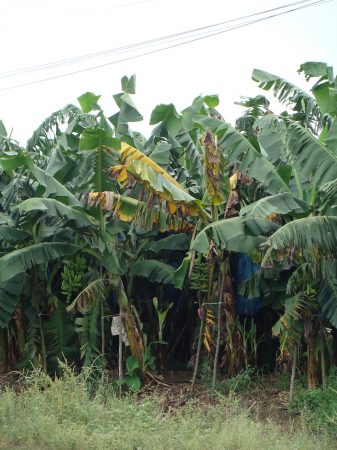
Enter Gert Kema. He’s a plant pathologist at Wageningen University and Research Centre in the Netherlands. (A pathologist is someone who studies disease.) Kema and his team are developing tests for TR4, including one called LAMP. This LAMP test relies on the polymerase chain reaction, or PCR. PCR copies particular snippets of DNA. LAMP looks for pieces of this genetic material that belong to the fungus. The new test would allow farmers to test suspicious plants, soil and water for those snippets of TR4’s DNA, even out in their banana fields.
Most standard PCR tests must be done at specific temperatures. LAMP, however, requires no heating or cooling. And the test equipment can be powered by a battery. That makes it ideal for banana farmers living in remote locations (without access to electricity).
Once the test is ready to run, farmers will be able to monitor their farms more effectively. If they do find TR4, they will have to work quickly to isolate the fungus. That means putting up fences, digging trenches and burning plants that might be infected. If those measures are successful, farmers could stop the disease in its tracks, guarding healthy nearby plants.
Fighting back
Detection of the fungus is essential. Still, the ultimate goal is the development of disease-resistant plants.
Swennen, the banana breeder, oversees a massive collection of banana plants. It’s at the International Transit Centre of Biodiversity International, or ITC. It’s in Leuven, Belgium, and houses all 1,400 of the world’s edible and inedible varieties. These bananas come from across the globe. And this center makes them freely available to people who need them. So far, more than 90,000 plants have been given to farmers in more than 100 countries.
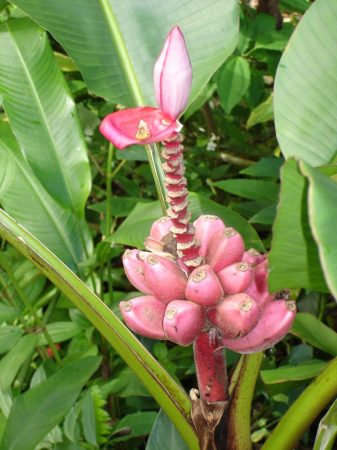
Most bananas at ITC are tropical. Some, however, come from places in China where it snows. Others prefer dry sites. Such broad varieties with so many different traits mean that lots of genetic material exists for breeders like Swennen to work with.
Some varieties hold genes that give a banana its flavor, climate hardiness or vigor. Some genes also may provide resistance to Panama disease. Breeding new varieties from one parent that is tasty and another that is disease-resistant (a technique called cross-breeding) might one day create dessert bananas immune to TR4.
Swennen works with teams in Uganda, Tanzania and Nigeria to cross-breed African bananas. These members of the International Institute of Tropical Agriculture (IITA) start their days early in the morning. They climb ladders to get to the tops of banana plants. They use brushes to remove pollen from the male flowers of one plant. They brush that pollen onto the newly opened female flowers of another. And then they wait. After three to four months, the flowers turn into fruits. From those fruits, the workers must collect seeds and then grow those seeds into new plants.
Seeds, though, are in short supply. Swennen estimates that he gets only 5 to 20 seeds per bunch of bananas (a bunch can contain anywhere from one to 200 fruits). Another complication: Those seeds can’t simply be planted in soil. They won’t grow. Instead, Swennen must cut open the seed, releasing the tiny embryo into a nutrient bath. Only 30 percent of the released embryos will develop into plants.
Despite such challenges, IITA and Uganda’s National Agricultural Research Organization have succeeded in breeding disease-resistant plants. So far, they have 27 varieties of East African cooking bananas that are resistant to both the Black Sigatoka fungus and the worm-like nematodes that have long been problems for banana growers. The process is painfully slow: Those 27 varieties took 20 years of cross-breeding.
But it’s worth the effort, says Swennen. Disease resistance is particularly important for farmers who don’t have the money to spray their crops with pesticides.
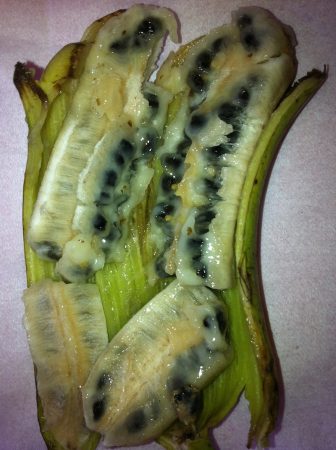
When small farmers in Asia and Africa plant the new varieties, they will be able to grow enough bananas to sustain their families. And these farmers won’t just eat the fruit. They’ll use all parts of the plant.
Broad leaves become the family’s plates. Stacked on the roof, those leaves will keep out the rain. Fibers from the banana plant’s stem go into making clothing and ropes. And once the banana fruits have come and gone, farm families will eat the plant’s stem and the bulbous base that grows underground, called the corm. Different types of bananas also have different flavors and are prepared in different ways. That’s why a farmer may grow between four and 20 different varieties.
In some ways, small farmers in Asia and Africa have less to worry about than do those at big plantations, Swennen says. That’s because each small farmer plants a variety of crops. That diversity helps protect the plants: Most of the crops a disease-causing organism encounters will not be susceptible. That will make it harder for a pathogen to find a suitable host. And even if one type of banana gets infected and wiped out, the grower will still have other varieties on which to rely.
Helping Mother Nature
Half a world away, in Latin America, TR4 remains a distant threat. It has to cross an ocean before it can wreak havoc on the huge plantations there. On this western side of the Atlantic, plantations specialize in Cavendish bananas. Eight out of 10 Cavendish sold in other parts of the world will have come from Latin America.
Every Cavendish plant is genetically identical to all others. So all of these clones are equally susceptible to TR4. Scientists believe it is only a matter of time before the fungus arrives. When it does, TR4 could spell the end of the sweet dessert banana Westerners have come to know and love.
But that won’t mean it’s the end of dessert bananas. At least not if James Dale has his way. This biotechnologist at Queensland University of Technology, in Australia, hopes to protect the varieties now on store shelves.
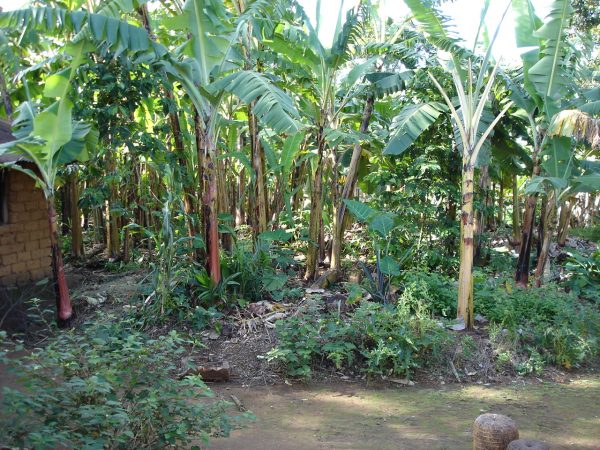
Cross-breeding produces new varieties of bananas that can have different tastes or textures than the ones we now eat, he explains. So Dale adds to existing varieties the genes that make a plant resistant to TR4. His method may keep the best features of our dessert banana (flavor, texture and its ability to be shipped long distances) while adding disease resistance.
Dale starts by taking genes from wild bananas. These bananas are full of big, hard seeds, so they aren’t good for eating. But the wild plants are resistant to both strains of Panama disease — TR4 and Race 1.
Dale doesn’t just want to protect Cavendish. He also hopes to bring back Gros Michel. It’s much more flavorful than Cavendish, he says. So he is inserting resistance genes into both types of plants.
To do so, Dale uses a common soil bacterium that naturally inserts pieces of DNA into plants. He takes a single cell from a Cavendish or Gros Michel banana plant. Then he uses the bacterium to insert the genes that would make the plant resist infection by TR4 or Race 1. The plant cells incorporate the genes into their own DNA. As they grow, they are able to fight off both types of Panama disease.
Dale’s studies are still in the trial stage. But he hopes that soon, resistant Cavendish and Gros Michel will be available to growers. If he succeeds, it would buy more time for bananas. Despite these advances, however, scientists will have to remain vigilant in the fight to protect the world’s most popular fruit.
Power Words
bacterium (plural bacteria) A single-celled organism forming one of the three domains of life. These dwell nearly everywhere on Earth, from the bottom of the sea to inside animals.
biotechnologist A scientist who uses living cells to make useful things.
clone An organism that has exactly the same genes as another, like identical twins. Often a clone, particularly among plants, has been created using the cell of an existing organism.
cooking banana Bananas eaten while still green. Grown in the East African highlands, cooking bananas are steamed or boiled into a porridge.
cross-breeding Taking pollen from one plant variety and using it to pollinate flowers of another variety. The cross-bred plants will exhibit features of both parent plants.
DNA (short for deoxyribonucleic acid) A long, spiral-shaped molecule inside most living cells that carries genetic instructions. In all living things, from plants and animals to microbes, these instructions tell cells which molecules to make.
fungus (plural: fungi) Any of a group of unicellular or multicellular, spore-producing organisms that feed on organic matter, both living and decaying. Molds, yeast and mushrooms are all types of fungi.
gene A segment of DNA that codes, or holds instructions, for producing a protein. Offspring inherit genes from their parents. Genes influence how an organism looks and behaves.
hypha (plural: hyphae) A tubular, threadlike structure that makes up part of many fungi.
immune Able to ward off a particular infection or show no impacts from a particular poison. More generally, the term may signal that something cannot be hurt by a particular drug, disease or chemical.
monoculture Large areas planted with a single type of crop.
nematode Type of roundworm, usually found in soil. It is very small, with no eyes, ears or nose.
nutrients Vitamins, minerals, fats, carbohydrates and proteins needed by organisms to live, and which are extracted through the diet.
pathogen An organism that causes disease.
pathologist Someone who studies disease and how it affects infected organisms.
photosynthesis (verb: photosynthize)The process by which green plants and some other organisms use sunlight to produce foods from carbon dioxide and water.
plantain A starchy, green banana that is fried before it is eaten.
polymerase chain reaction (PCR) A biochemical process that repeatedly copies a particular sequence of DNA.
resistance (as in disease resistance) The ability of plants to fight off disease.
spore The single-celled reproductive stage of a fungus (functioning much like a seed) that is released and spread by wind or water. Most are protected against drying out or heat and can remain viable for long periods, until conditions are right for their growth.
sucker A shoot from the base of a plant.
tissue culture (as in plant tissue culture) The process of taking cells from a plant, putting them in a nutrient bath and adding plant hormones to stimulate the cells to develop into new plants. Tissue culture is commonly used to create genetically identical plants.
Tropical Race 4 (TR4) The fourth identified strain of the fungus that causes Panama disease. TR4 is the deadliest strain, currently threatening nearly 85 percent of the world’s bananas.
wilt Plant tissue that loses water and turns limp because it no longer possesses any internal support. Some plant diseases are also called wilts. That’s because they cause their infected hosts to turn hopelessly limp and die.


